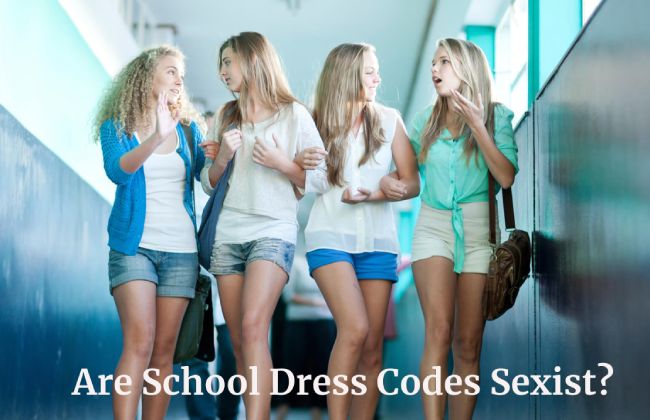The fact that females tend to get written up for dress code violations more often than males has been widely reported in the media. In spite of this, are dress codes sexist in nature?
Why Dress Codes Are Considered Sexist
A number of people argue that dress code violations are sexist because dress codes themselves tend to target female students in particular.
Target Female Clothing
The majority of people feel that dress codes tend to target women’s clothing due to the fact that they tend to ban certain clothing items that women typically wear, and they usually require clothing that is not readily available for women (but is for men).
Females are generally the ones who typically wear tank tops, yoga pants, and leggings, which are typically forbidden by typical dress codes. In addition, guidelines such as the “fingertip rule” state that students’ shorts should be longer than their fingertips when their hands are at their sides when their hands are down at their sides.
There are plenty of longer shorts available for boys, but the majority of girls’ shorts do not reach this length.

Prioritizes Boys’ Classroom Needs
Often times the wording of a dress code specifies that female students should dress in a particular manner in order not to distract boys because their clothing is distracting to them. In order to prevent male students from becoming distracted, shorts and skirts should be longer than fingertips as you do not want to expose your thighs because that might cause a male student to become distracted.
Shirts should be worn up to the neckline, because cleavage can be distracting to other people. In order for your rear end not to be visible while wearing leggings, you should wear a long shirt over them. As a consequence, this dress code is tailored specifically for female students and implies that the education of girls is not as important as that of boys.
The banning of these kinds of clothing takes away the comfort level of a female student at best, and at worst, it implies that girls are not as important as boys when it comes to comfort in a classroom, and that boys should behave accordingly.
Body Shames Girls
Are you looking for another reason why school dress codes should be abolished? It is important to remember that girls come in all shapes and sizes. Further, the teenage years are a time of significant growth for a girl’s self-image, and can be seen as a pivotal period in her life.
As a result, many kids want to dress like their friends when they go to school. A shirt might fit according to regulations on one girl, but on another, it might show cleavage, whereas it might fit according to regulations on one girl.
Consequently, you have punished a girl for having larger breasts due to the fact that she has bigger breasts. There will come a point in this situation where a girl with a larger chest will begin to feel self-conscious.
You can also take a look at the fingertip rule again if you wish. Those girls who have long legs and arms are punished by having to wear longer shorts than those who have shorter legs and arms.
The distinctions in the dress code can have a negative impact on a child’s self-esteem during a critical time in a child’s life when the child is growing up.
How Dress Codes Are Changing
In many cases, the purpose of dress codes is to ensure that all students feel comfortable in the classroom, and to ensure modesty when attending events outside of the classroom. In spite of the fact that these codes are necessary, many schools are modifying the wording in order to ensure that their codes are gender neutral.
Modified Wording
A number of schools have addressed sexism in the dress code by altering the language of their dress code in order to address the issue. As an example, they have removed wording such as showing cleavage and covering the private parts of the female body.
Furthermore, some schools have simplified their dress codes in order to make them easier to follow. A dress code for example, simply explains what constitutes a shirt, pants/shorts, and a dress/skirt for each student in the school.
There was an incident that took place at Indian Hills High School in Wisconsin when students protested the sexist dress code that was enforced more heavily on girls than for boys through various means in order to protest the sexist policy.
A result of this has been that the school has modified the dress code in order to make it more gender neutral. Across the country, the same changes are taking place at the same time.
Promotes Positive Learning Environment
Many proponents of dress codes point out that a dress code promotes safety and learning in a public school. With the right language, a dress code is meant to make everyone feel safe and to reduce fights and bullying in schools.
It has also been shown that a dress code can enhance learning.
Alleviates Pressure
Sexualization of women is everywhere. TV shows to entertainers and in between are all sexualized. Dress codes help to alleviate the pressure on students, allowing them to dress modestly. Dress codes still allow room for self-expression but in a controlled environment.
The Problem With Dress Codes
Dress codes are a sticky area for most parents and schools. While most schools need to update the wording of their dress codes, there are ways to ensure that the dress code in your school ensures modesty among students without harming a person’s self-expression or self-esteem.
